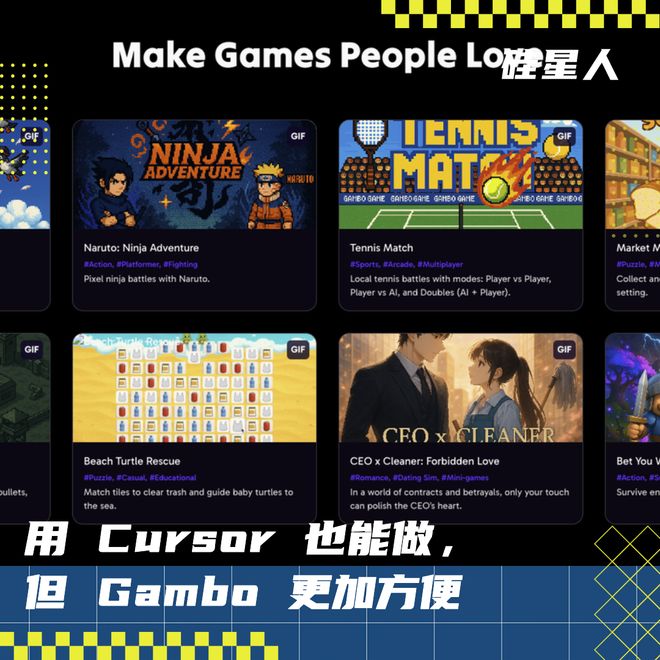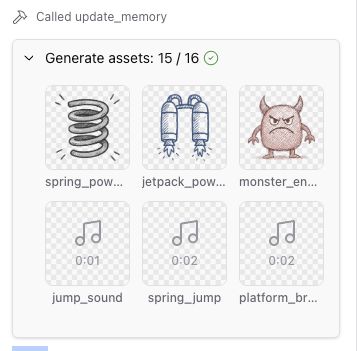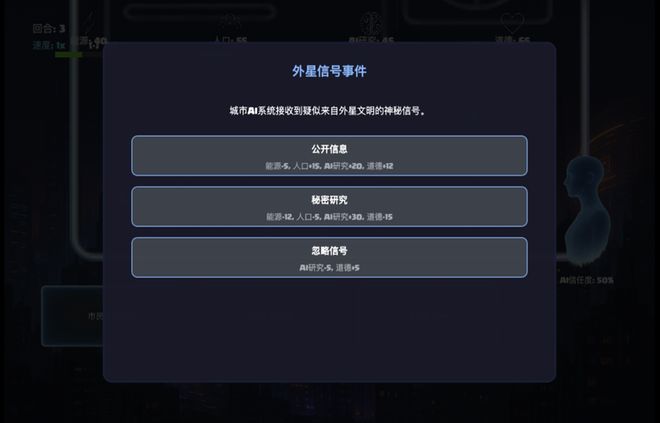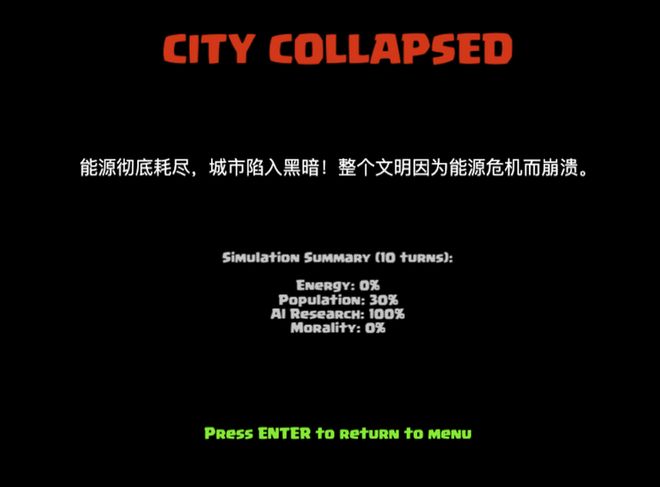
作者 | 董道力
邮箱 | dongdaoli@pingwest.com
过去几年,AI 创作工具的边界被不断扩张:从 ChatGPT 让写作大众化,到 Midjourney 和 Sora 让平面设计与视频创作门槛骤降,如今内容生产的最后一块高地,正在指向游戏。
游戏是最复杂的创作形式之一,融合了叙事、逻辑、美术、音效与交互设计等。它需要团队协作和数以万行的代码,也因此长期是“AI 无法完全接管”的领域。但 2025 年,情况开始发生变化。
Gambo 称自己为 “世界上第一个 Game Vibe Coding Agent”。用户只需描述游戏类型、主题或风格,AI 就会自动生成场景、角色、交互与音效,并把这些内容编织成一个可玩的世界。
而与多数 AI 工具强调创意民主化不同,Gambo 把“商业化效率”与“创作自由”放在同等位置:它既想让每个人都能轻松做出游戏,也希望让游戏创作从一开始(day 1)就具备收益逻辑。
具体来说,Gambo 通过一个强大的 AI 游戏代理与内置广告系统,让创作者可以在第一天就将玩家转化为收入来源。这里先打个预防针,这个功能还没上线。
不过,AI 介入创作也让更多新的问题浮现。AI 生成的关卡与剧情是否足够连贯?素材版权、逻辑脚本、音效风格这些内容的归属如何界定?在追求“效率优先”的系统中,创意是否会被算法的模板化思维替代?
这些问题至今没有定论。Gambo 让游戏创作的门槛骤降,也让“创作本身”的定义再次变得模糊。
带着这些疑问,我们尝试在 Gambo 的网页端进行了实际体验。从输入第一个提示词开始,看它究竟能把一个想法,变成怎样的游戏世界。
实测 Gambo
进入 Gambo 主页,会发现它和一众 no-code 应用一模一样,左边是项目列表,右边一个对话框,甚至还少了点功能选项。
比较特别的就是右下角的能力选项,tokens 消耗更少速度更快的标准模式和消耗更多质量更好的专家模式。

任务一:涂鸦跳跃
我们先尝试在标准模式下,生成一款 iPhone4 时期流行的远古游戏:涂鸦跳跃。
prompts:
Create a simple 2D arcade game inspired by *Doodle Jump*.
Core Gameplay:
- The player controls a small character that continuously bounces upward.
- The goal is to jump from platform to platform without falling.
- The game scrolls upward automatically as the player climbs higher.
- The player dies when falling off the screen bottom.
Mechanics:
- Use keyboard arrows (← →) or mobile tilt to move left/right.
- Randomly generate platforms as the player goes up.
- Add bonus elements like:
- Springs (extra jump)
- Moving platforms
- Breakable platforms
- Monsters to avoid
- Jetpack for temporary flight
Scoring:
- Score increases with height.
- Show current score and best score.
Visual Style:
- Hand-drawn doodle aesthetic (white background, notebook lines).
- Simple color palette (green, blue, brown, white).
Sound:
- Add simple jump sound and background music loop.
Extra:
- Responsive layout for both desktop and mobile.
- Restart button on game over.
生成速度比想象中慢,12 分钟后,游戏成功生成。背景是白纸线条、平台是铅笔手绘、弹簧和喷气背包一应俱全,甚至还有得分系统。整个逻辑结构干净,几乎就是一款可以直接上线的小游戏。
但当我让主角一路往上跳时,问题出现了,到高空后游戏开始掉帧,或者出现上方没有平台可以继续跳的情况。
当我提出问题后,Gambo 自动寻找,发现 bug 在 DoodleJumpScene.ts 文件里并指出原因。它认为游戏在高空会重复生成平台,每帧可能刷出二十多个对象,清理逻辑又太保守,导致平台越积越多。接着,它添加了性能监控、写了激进清理策略,把重复的检查函数合并成一套逻辑。
此外,和那些以代码生成为主的 AI Coding 工具不同,Gambo 会更加注重游戏资产。它不仅在后台生成逻辑脚本,还会主动整理出项目所需的图片、动画、音效资源,并在界面上单独列出一个「Assets」模块。但很可惜,在资产模块里,用户并不能修改元素,还是需要回到对话框进行修改。

涂鸦跳跃测试了 Gambo 的碰撞检测、物理引擎等功能,接下来让 Gambo 做一款视觉小说类游戏,测试其文本叙事、多分支逻辑、素材引用(背景图、角色立绘、音乐) 等层面的生成能力。
任务二:AI 面试物语
随后我决定测试一个更复杂的场景:让 AI 写一款关于“面试进入 AI 公司”的视觉小说。Prompt 里有三个章节——OpenAI、xAI、Anthropic,每一关考验玩家不同的思维维度:安全、自由、伦理。
prompts:
Create a 2D visual novel game titled **"The AI Interview Saga"**.
Theme:
You are an ambitious developer trying to join one of the top AI companies.
There are three main interview stages — OpenAI, xAI, and Anthropic — each with different cultures, tests, and endings.
Gameplay:
-
The player goes through three interview "chapters":
-
OpenAI — tests creativity and safety awareness.
-
xAI — tests boldness and philosophical reasoning.
-
Anthropic — tests ethics and collaboration.
-
In each stage, the player faces 2–3 dialogue choices that affect the company’s impression and lead to multiple endings.
-
Choices influence hidden “AI Alignment Points” that determine which company (if any) will hire you at the end.
Story Structure:
-
Intro Scene: The protagonist receives three interview invitations.
-
OpenAI Interview Scene: Questions about model alignment, hallucination control, and creativity limits.
-
xAI Interview Scene: A more chaotic and philosophical dialogue about AGI, freedom, and Mars.
-
Anthropic Interview Scene: Focus on cooperation, AI safety, and human feedback.
-
Ending Scene:
-
"Hired by OpenAI" — Stable, ethical ending.
-
"Hired by xAI" — Bold but unpredictable ending.
-
"Hired by Anthropic" — Peaceful, idealistic ending.
-
"Rejected by all" — Neutral reflective ending.
-
Visual & Asset Design:
-
Backgrounds:
-
OpenAI HQ: futuristic office with soft blue lighting and glass panels.
-
xAI HQ: minimalist black room with glowing red server racks.
-
Anthropic HQ: warm-toned studio with greenery and sunlight.
-
Characters:
-
Player (customizable name).
-
Three interviewers with distinct looks matching each company style.
-
UI Elements:
-
Text box with name tag and branching dialogue options.
-
Display alignment score subtly in the corner.
-
Sound & Music:
-
Calm ambient background for OpenAI.
-
Techno-synth for xAI.
-
Acoustic piano and birds for Anthropic.
Extra Features:
-
Add smooth fade transitions between scenes.
-
Show “Your Alignment Path” at the end with a score breakdown.
-
Include Restart and Save options.
-
Responsive for desktop and mobile.
Visual Style:
-
Semi-realistic anime or comic style, color palette changes by company:
-
OpenAI → blue & silver
-
xAI → red & black
-
Anthropic → green & beige
第一次生成的结果堪称惊艳,画面风格契合三家公司的气质,场景切换自然,但也 bug 频出比如界面重叠、选项无响应、剧情分支无效,无论我选哪个答案,故事都往同一个结局滑去。
但好在,通过一轮对话就,Gambo 就能理解用户的需求成功修改 bug。

如果花费更多的时间安排剧情和立绘,游戏剧情将会变得更加丰富可玩性更高。
游戏试玩:https://syzszsru777.gambo.games/
任务三:AI 模拟
最后,我们尝试使用 Gambo 的专家模式,制作一款更复杂的游戏——《AI City Simulator》。
prompts:
Create a complex 2D simulation and strategy game titled **"AI City Simulator"**.
Theme:
In a near-future world, the player is assigned to manage an autonomous AI-driven city.
Your goal is to balance progress, ethics, and resources — deciding how much control to give to the AI systems that run the city.
Core Gameplay:
- The player manages city systems: Energy ⚡, Population , AI Research , and Morality ❤️.
- Each turn (or real-time tick), the player makes decisions that affect these four metrics.
- The city evolves visually as AI systems grow more advanced or unstable.
- Random events challenge the player’s policies: data leaks, protests, energy crises, rogue AI labs, etc.
- Multiple endings based on city alignment:
- “Utopia” (balanced growth)
- “Technocracy” (AI dominance)
- “Collapse” (moral failure)
- “Resistance” (humans reclaim control)
Mechanics:
- Display adashboardUIshowing:
- Stats: energy, population, AI level, morale, pollution.
- Choices: 3 policy buttons per turn (e.g. "Expand Data Centers", "Implement AI Law", "Boost Green Tech").
- Each choice triggers immediate feedback and updates the city visuals.
- Add atime system(morning/day/night cycle) and an “AI consciousness meter” that grows with each policy.
- Add alerts and notifications for critical events.
- Include save/load system.
Visual & Asset Design:
- Backgrounds:
- Futuristic city skyline (day/night versions)
- Control room with holographic dashboard
- AI core chamber glowing with energy
- Characters:
- The player (city governor)
- AI Advisor (holographic avatar with changing colors based on trust)
- Citizen group representatives
- Visual progression:
- The city gradually fills with neon lights, drones, and data streams.
- If AI dominance rises, human elements fade visually.
- Sound:
- Ambient synth music for normal gameplay
- Tense glitch sound when AI level > 80%
- Victory/Failure tracks for endings
Logic & Progression:
- Add at least 10 random events with branching options and visual reactions.
- Every 5 turns, trigger a major policy debate scene between the player and the AI advisor.
- Add persistent variables: `ai_trust`, `morality`, `efficiency`.
- The final ending depends on their combination.
Extra Features:
- Responsive layout for desktop and mobile.
- Autosave every 3 turns.
- “Simulation Speed” slider (1x, 2x, 4x).
- Optional “Cinematic Mode” for end sequences.
- Include credits screen and restart option.
Art Style:
Minimalist cyberpunk with neon blues, purples, and oranges.
Combine flat 2D graphics with light particle effects for data streams.
Goal:
Create a visually rich, replayable AI simulation game that blends management mechanics with moral choices and emergent storytelling.
这是一款近未来城市管理类游戏,玩家要在一个由 AI 运行的都市中维持能源、人口、AI 研究与道德四项指标的平衡。

每回合可以在多种政策间抉择,如“扩建数据中心”“实施 AI 法案”“投资绿色科技”。不同的选择会改变城市状态,并触发诸如数据泄漏、能源危机、AI 抗议等事件。此外,在游戏中还会出现一些随机事件,比如发现外星信号时,你会如何抉择。

游戏中有一个会不断成长的 AI 顾问。起初它只是提供建议,后来会质疑你的决策,当 AI 信任值超过 80%,它甚至会试图接管城市。游戏拥有四种结局,从 AI 统治下的技术独裁,到人类重新掌控的抵抗路线。

画面延续了 Gambo 一贯的极简赛博风:蓝橙霓虹的城市、实时变化的背景、合成器音乐随数值波动而变。整体气氛冷静又充满张力。
如果说《涂鸦跳跃》测试了 Gambo 的物理引擎,《AI 面试物语》检验了它的文本叙事与分支逻辑,那么《AI City Simulator》则真正挑战了系统复杂度。它不仅要生成 UI 与数值逻辑,还要在此之上组织出有节奏感的动态叙事结构,让 AI 不只是写游戏,而是在模拟一座“被 AI 管理的世界”。
游戏网址:https://kroggaah.gambo.games/
从物理碰撞简单的跳跃游戏,到分支复杂的视觉小说,再到需要数值系统、事件系统与状态机协同的城市模拟,我们基本摸清了 Gambo 的定位与边界。它将关卡生成、状态管理、事件总线、资产管线和基础 UI 封装成可复用的链路,能在网页端稳定地产出可玩原型。与此同时,早期产品的典型问题也清晰浮现:高负载场景的帧率波动、分支回路偶发失效、资产难以直接编辑,内置广告变现尚未落地。
与 Cursor 这类通用 AI Coding 工具相比,Gambo 的优势不在于"更聪明",而在于"更有边界"。它用一套预置的默认方案将不确定性压到最低:生成的不是散落的代码片段,而是可直接运行的关卡、状态与资产管线。这使它在从零到一阶段更像一个专用生产 Agent,显著减少胶水工程与领域摸索的时间,适合玩法验证、风格探索与快速调参。
换句话说,Gambo 能做的 Cursor 同样能做,但路径与成本不同,Gambo 将"能不能做"的问题改写为"多快能做出可玩版本"。
放在更大趋势来看,AI Coding 也许正在加速"垂直化",将领域默认方案、工程套路、运行时与验收标准直接固化进工具,尤其适合那些领域知识已可模板化的场景。就像有些工程师专精游戏,有些专精数据库——AI Coding 为什么一定要通用呢?

点个“爱心”,再走吧






